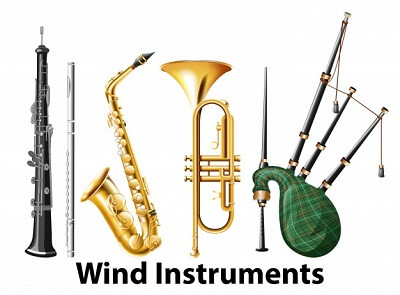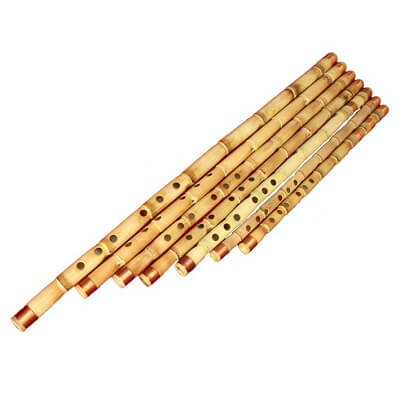Wind Instruments
 Any musical instrument that uses air as the primary vibrating medium for the production of sound. Wind instruments include the woodwinds, such as the flute, the clarinet, the oboe, and the bassoon. Wind instruments also include brass instruments, such as the trumpet, the horn, the trombone, and the tuba. The saxophone is considered a woodwind, but it may be made of brass.
Any musical instrument that uses air as the primary vibrating medium for the production of sound. Wind instruments include the woodwinds, such as the flute, the clarinet, the oboe, and the bassoon. Wind instruments also include brass instruments, such as the trumpet, the horn, the trombone, and the tuba. The saxophone is considered a woodwind, but it may be made of brass.
Wind instruments exhibit great diversity in structure and sonority and have been prominent in the music of all cultures since prehistoric times. A system of classification of these instruments must reflect and categorize the relationships and the differences between the many varieties. The conventional division of the symphony orchestra into sections has simplified the grouping of wind instruments into woodwinds and brasses, but this is an inaccurate classification that generally does not apply outside Western culture. The fact that some modern woodwinds, such as flutes and saxophones, are made of metal whereas several ancestors of present-day brasses, such as the cornett and the serpent, were typically made of wood illustrates the unsuitability of a classification according to material.
The standard method of instrument classification was introduced in 1914 by Curt Sachs and Erich von Hornbostel. It is based on the acoustical principles of an instrument’s sound, regardless of its stylistic or cultural context. In this system, all wind instruments—that is, all instruments in which air itself is the primary vibrating medium for the production of sound—are called aerophones, whether or not the air is enclosed in a tube.
Flutes and reeds
 Sound is generated by different methods in the aerophones designated as flutes and reeds in the Sachs-Hornbostel system. In flutes, the airstream is directed against a sharp edge; in reeds, the air column in the tube is caused to vibrate between beating parts of a multiple reed or between a beating single reed and a mouthpiece.
Sound is generated by different methods in the aerophones designated as flutes and reeds in the Sachs-Hornbostel system. In flutes, the airstream is directed against a sharp edge; in reeds, the air column in the tube is caused to vibrate between beating parts of a multiple reed or between a beating single reed and a mouthpiece.
Essential to sound production in reedpipes is the reed itself. Those used on most Western instruments are typically made from the stems of the large semitropical grass Arundo donax, commonly referred to by wind players as cane, grown on the Mediterranean coasts of France, Spain, and Italy. (Substitutes for cane-wood, whalebone, silver, and plastic also have been tried.) Seasoned over a period of years, cane reeds may be purchased finished or be made by the players themselves.
The double reed for an oboe or a bassoon is made from a strip of cane about twice the length of the finished reed. The inner surface is gouged thin, shaped to be narrower at the ends, and notched in the middle. The reed is then soaked in water and folded in half at the notch. The free ends are bound with thread and, for oboes and English horns, mounted on a short tapered metal tube called a staple. A bassoon reed is bound with thread and wire over a steel mandrel, which is later removed to leave a hollow rounded stem. To finish the reed, the halves are separated at the notch and the tips scraped to a feather edge on the outside. The form and degree of “scrape” applied to the tip of the reed have a profound influence on its behaviour and may vary a great deal from player to player. In playing, the double reed of the oboe and the bassoon is held by the tension of the lips drawn in over the teeth. The opening between the two blades of the reed alternately opens and closes with the pressure of the breath to generate the pulsations in the tube.
Types
- Brass Instruments
- Woodwind Instruments
Brass Instruments
Brass instrument, in music, any wind instrument—usually of brass or other metal but formerly of wood or horn—in which the vibration of the player’s lips against a cup- or funnel-shaped mouthpiece causes the initial vibration of an air column. A more precise term is lip-vibrated instrument. Ethnologists frequently refer to any instrument of this class as a trumpet; but when they are made of or derived from animal horns, they are also often known as horns. Typical brass instruments in a Western orchestra are the trumpet, trombone, French horn, and tuba Read More
Woodwind instruments
The Woodwind instruments all used to be made of wood, which gives them their name. Today, they are made of wood, metal, plastic or some combination. They are all basically narrow cylinders or pipes, with holes, an opening at the bottom end and a mouthpiece at the top. You play them by blowing air through the mouthpiece (that's the "wind" in "woodwind") and opening or closing the holes with your fingers to change the pitch. Metal caps called keys cover the holes of most woodwind instruments. Read More